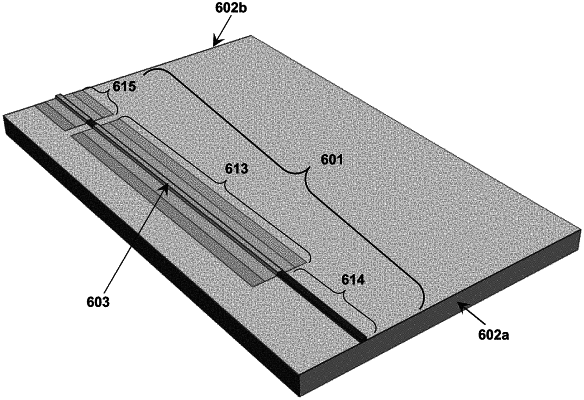| CPC G01N 21/59 (2013.01) [G01J 3/1895 (2013.01); G01J 3/2803 (2013.01); G01N 21/255 (2013.01); G01N 21/27 (2013.01); G02B 6/102 (2013.01); H01S 5/0215 (2013.01); H01S 5/0262 (2013.01); H01S 5/0287 (2013.01); H01S 5/0421 (2013.01); H01S 5/101 (2013.01); H01S 5/125 (2013.01); H01S 5/2063 (2013.01); H01S 5/2206 (2013.01); H01S 5/3402 (2013.01); H01S 5/343 (2013.01); G01N 2201/0612 (2013.01); H01S 5/062 (2013.01); H01S 5/0612 (2013.01)] | 11 Claims |

|
1. A chemical sensor comprising:
a semiconductor laser having highly stable output intensity and spectral characteristics, the semiconductor laser comprising an active gain waveguide formed in a laser cavity having a first and a second end opposite the first end,
the first end comprising a first facet coated with a first dielectric spacer and a first highly reflective metal or having a first distributed Bragg reflector (DBR) formed therein,
the second end comprising a second facet either coated with a second dielectric spacer and a second highly reflective metal or having a second DBR formed therein,
the active gain waveguide producing laser light having a wavelength that is tunable by variation of an operating temperature of the semiconductor laser or by variation of a current flowing through the active gain waveguide,
the first and second highly reflective metals or DBRs on the first and second ends preventing the laser light produced by the active gain waveguide from being passed from the ends of the laser cavity and being fed back into the laser cavity following interactions of the laser light with external optical elements;
the laser cavity further including an extended passive sensing waveguide and a detector waveguide situated within the laser cavity, the active gain waveguide, the extended passive sensing waveguide, and the detector waveguide all being formed on a single semiconductor wafer,
a first end of the passive sensing waveguide being coupled to output from the laser cavity and a second end of the passive sensing waveguide being coupled to the detector waveguide, and
the detector waveguide including a corresponding narrow ridge waveguide that is similar to or the same as the active gain waveguide, the detector waveguide further including a top electrical contact configured to detect a photocurrent produced by light propagating in the detector waveguide when it is operated at zero bias, under a reverse bias, or under a forward bias below that required to reach a lasing threshold of the active gain laser waveguide;
wherein a top surface of the extended passive sensing waveguide section is exposed to an ambient sample gas or liquid; and
wherein a photocurrent flowing through the detector waveguide provides information regarding the sample gas or liquid by providing information about at least one spectral characteristic of an absorption of the laser light by the sample gas or liquid.
|